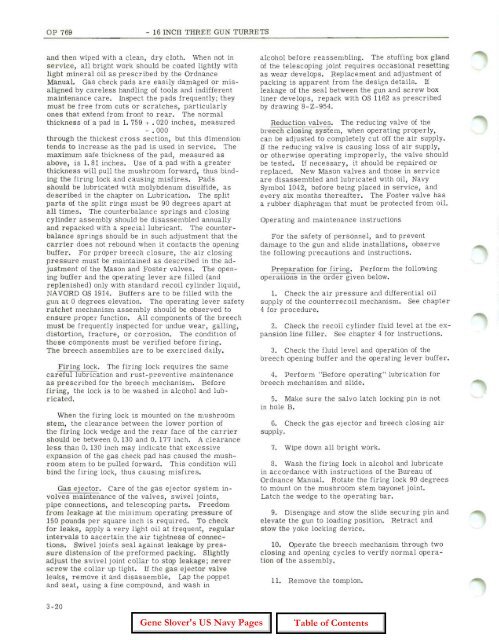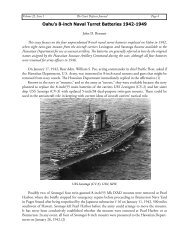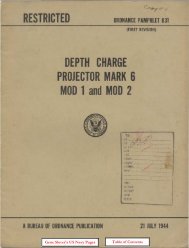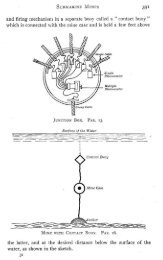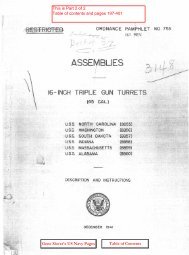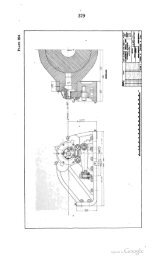OP-769 16" Three Gun Turrets Part 2 - Personal Page of GENE ...
OP-769 16" Three Gun Turrets Part 2 - Personal Page of GENE ...
OP-769 16" Three Gun Turrets Part 2 - Personal Page of GENE ...
Create successful ePaper yourself
Turn your PDF publications into a flip-book with our unique Google optimized e-Paper software.
<strong>OP</strong> <strong>769</strong> - 16 INCH THREE GUN TURRETS<br />
and then wiped with a clean, dry cloth. When not in<br />
service, all bright work should be coated lightly with<br />
light mineral oil as prescribed by the Ordnance<br />
Manual. Gas check pads are easily damaged or misaligned<br />
by careless handling <strong>of</strong> tools and indifferent<br />
maintenance care. Inspect the pads frequently; they<br />
must be free from cuts or scratches, particularly<br />
ones that extend from front to rear. The normal<br />
thickness <strong>of</strong> a pad is 1. 759 + .020 inches, measured<br />
- .000<br />
through the thickest cross section, but this dimension<br />
tends to increase as the pad is used in service. The<br />
maximum safe thickness <strong>of</strong> the pad, measured as<br />
above, is 1. 81 inches. Use <strong>of</strong> a pad with a greater<br />
thickness will pull the mushroom forward, thus binding<br />
the firing lock and caUSing misfires. Pads<br />
should be lubricated with molybdenum disulfide, as<br />
de scribed in the chapter on Lubrication. The split<br />
parts <strong>of</strong> the split rings must be 90 degrees apart at<br />
all times. The counterbalance springs and closing<br />
cylinder assembly should be disassembled annually<br />
and repacked with a spec ial lubricant. The counterbalance<br />
springs should be in such adjustment that the<br />
carrier does not rebound when it contacts the opening<br />
buffer. For proper breech closure, the air clOSing<br />
pressure must be maintained as described in the adjustment<br />
<strong>of</strong> the Mason and Foster valves. The opening<br />
buffer and the operating lever are filled (and<br />
replenished) only with standard recoil cylinder liquid,<br />
NAVORD OS 1914. Buffers are to be filled with the<br />
gun at 0 degrees elevation. The operating lever safety<br />
ratchet mechanism assembly should be observed to<br />
ensure proper function. All components <strong>of</strong> the breech<br />
must be frequently inspected for W1due wear, galling,<br />
distortion, fracture, or corrosion. The condition <strong>of</strong><br />
the se components must be verified before firing.<br />
The breech assemblies are to be exercised daily.<br />
Firing lock. The firing lock requires the same<br />
careful lubrication and rust-preventive maintenance<br />
as prescribed for the breech mechanism. Before<br />
firing, the lock is to be washed in alcohol and lubricated.<br />
When the firing lock is mounted on the mushroom<br />
stem, the clearance between the lower portion <strong>of</strong><br />
the firing lock wedge and the rear face <strong>of</strong> the carrier<br />
should be between O. 130 and O. 177 inch. A clearance<br />
less than O. 130 inch may indicate that excessive<br />
expansion <strong>of</strong> the gas checi, pad has caused the mushroom<br />
stem to be pulled forward. This condition will<br />
bind the firing lock, thus causing misfires.<br />
Gas ejector. Care <strong>of</strong> the gas ej ector system involves<br />
maintenance <strong>of</strong> the valves, swivel joints,<br />
pipe connections, and telescoping parts. Freedom<br />
from leakage at the minimum operating pTessure <strong>of</strong><br />
150 pounds per square inch is required. To check<br />
for leaks, apply a very light oil at frequent, regular<br />
intervals to ascertain the air tightness <strong>of</strong> connections.<br />
Swivel joints seal against leakage by pressure<br />
distension <strong>of</strong> the preformed packing. Slightly<br />
adjust the swivel joint collar to stop leakage; never<br />
screw the collar up tight. If the gas ejector valve<br />
leaks, remove it and disassemble. Lap the poppet<br />
and seat, using a fine compound, and wash in<br />
3-20<br />
alcohol before reassembling. The stuffing box gland<br />
<strong>of</strong> the telescoping joint requires occasional resetting<br />
as wear develops. Replacement and adjustment <strong>of</strong><br />
packing is apparent from the design details. If<br />
leakage <strong>of</strong> the seal between the gun and screw box<br />
liner develops, repack with OS 1162 as prescribed<br />
by drawing 8-2-954.<br />
Reduction valves. The reducing valve <strong>of</strong> the<br />
breech closing system, when operating properly,<br />
can be adjusted to completely cut <strong>of</strong>f the air supply.<br />
If the reducing valve is causing loss <strong>of</strong> air supply,<br />
or otherwise operating improper ly, the valve should<br />
be tested. If necessary, it should be repaired or<br />
replaced. New Mason valves and those in service<br />
are disassembled and lubricated with Oil, Navy<br />
Symbol 1042, before being placed in service, and<br />
every six months thereafter. The Foster valve has<br />
a rubber diaphragm that must be protected from oil.<br />
Operating and maintenance instructions<br />
For the safety <strong>of</strong> personnel, and to prevent<br />
damage to the gun and slide installations, observe<br />
the following precautions and instructions.<br />
Preparation for firing. Perform the following<br />
operations in the order given below.<br />
1. Check the air pressure and differential oil<br />
supply <strong>of</strong> the counterrecoil mechanism. See chapter<br />
4 for procedure.<br />
2. Check the recoil cylinder fluid level at the expansion<br />
line filler. See chapter 4 for instructions.<br />
3. Check the fluid level and operation <strong>of</strong> the<br />
breech opening buffer and the operating lever buffer.<br />
4. Perform "Before operating" lubrication for<br />
breech mechanism and slide.<br />
5. Make sure the salvo latch locking pin is not<br />
in hole B.<br />
6. Check the gas ejector and breech closing air<br />
supply.<br />
7. Wipe down all bright work.<br />
8. Wash the firing lock in alcohol and lubricate<br />
in accordance with instructions <strong>of</strong> the Bureau <strong>of</strong><br />
Ordnance Manual. Rotate the firing lock 90 degrees<br />
to mount on the mushroom stem bayonet joint.<br />
Latch the wedge to the operating bar.<br />
9. Disengage and stow the slide securing pin and<br />
elevate the gun to loading position. Retract and<br />
stow the yoke locking device.<br />
10. Operate the breech mechanism through two<br />
closing and opening cycles to verify normal operation<br />
<strong>of</strong> the assembly.<br />
11. Remove the tompion.


